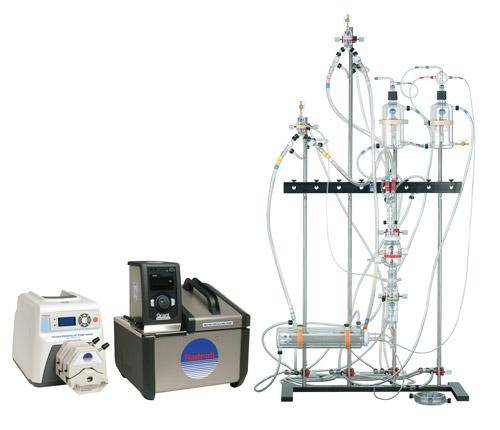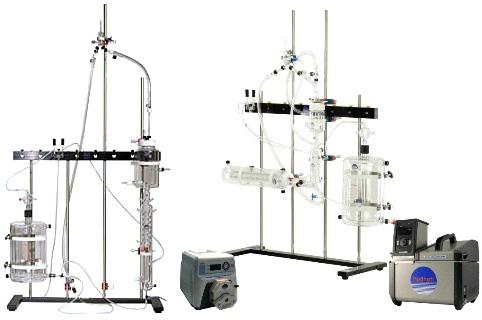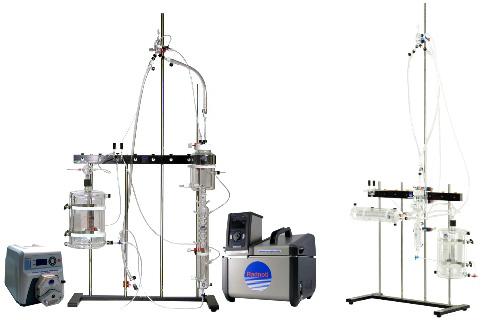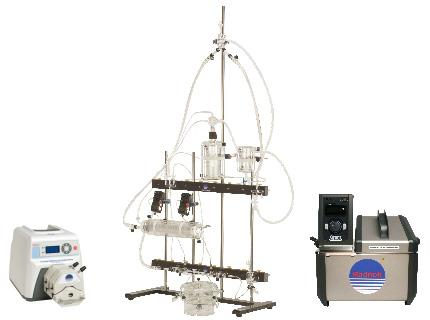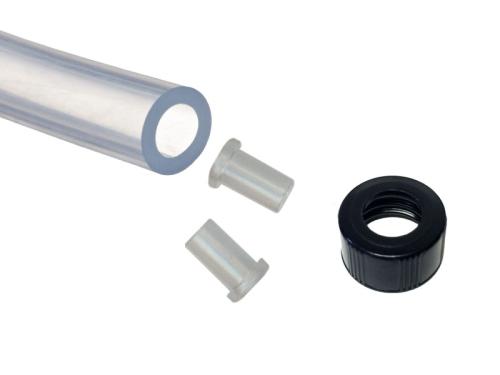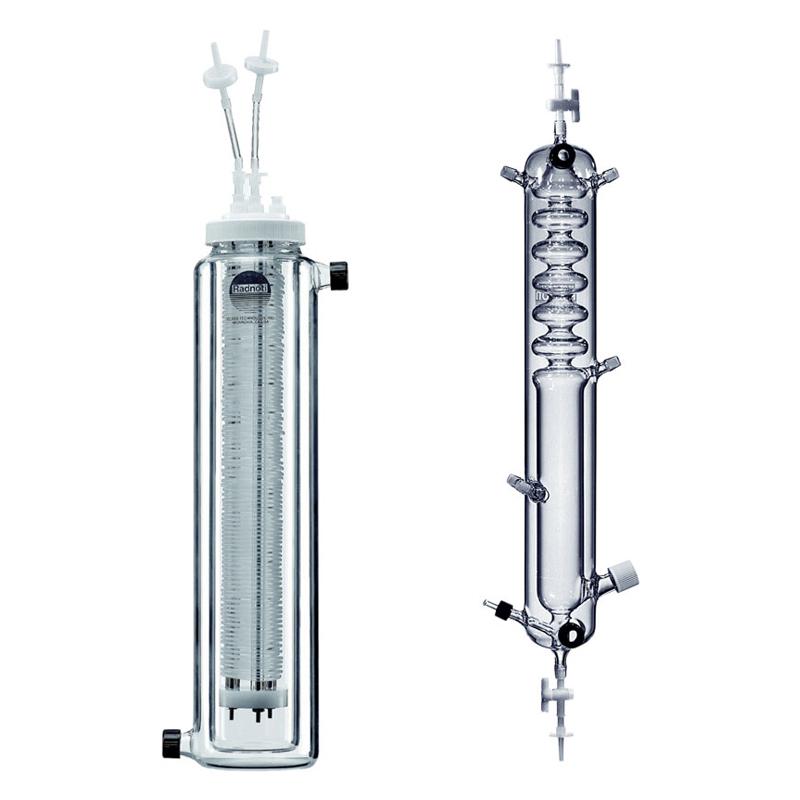
Radnoti Oxygenating Chambers
Overview
Radnoti Oxygenating Chambers are designed to provide additional reoxygenation of solution in a perfusion circuit, while maintaining the desired temperature. Therefore, they are constructed with borosilicate glass, which includes a water jacket outer compartment that uses Radnoti Quick Disconnect fittings to attach to a heated water perfusion circuit. Additionally, they attach to a Radnoti Lab Stand via Single Ring Clamps and Universal Stand Clamps.
Product Configurations
Radnoti Oxygenating Chamber (Sheet Flow)
Radnoti Oxygenating Chamber (Sheet Flow)
An oxygenating chamber that is designed to be vertically attached in a Radnoti Working Heart apparatus for rat hearts. Its upper chamber is a condenser, which is formed from six linked spheres that provide the maximal surface area for rewarming and reoxygenation of the perfusate. Perfusate passing through the condenser is collected in its lower chamber, which is designed to collect the perfusate. It has a port that allows the insertion of an Oxygenating Tube with Teflon Needle Valve to provide controlled gas delivery. Additionally, it has another specialized port for the option of inserting either a temperature or pH probe to monitor temperature or pH.
This oxygenating chamber has seven Luer ports, one entry port at the top, three side ports near the top of the upper chamber, two side ports connecting to the lower chamber, and one exit port at the bottom. Attachment of either 1- or 3-Way Luer Taps allows the top and side ports to be either used for entry or exit of perfusate overflow, perfusate return (for working heart mode), gassing, perfusate sampling or addition of drugs. The bottom exit port permits the reoxygenated perfusate to be pumped back to the isolated heart. It has a 160 mL volume, 370 mm overall average height and 48 mm water jacket OD.

Radnoti Oxygenating Chamber (Membrane)
Radnoti Oxygenating Chamber (Membrane)
An oxygenating chamber that is designed to be horizontally attached to a Radnoti Lab Stand via two Single Ring Clamps, which is then used to gas solutions that are being perfused at very low flow rates required for certain organs, tissues, and cells. They include Isolated Rodent Liver/Kidney and Mouse Langendorff and Working Heart setups.
The oxygenating chamber has a lid that seals an inner incubating chamber, and has gas inflow and outflow ports, which allow the chamber to be gassed from a gas supply (depending on the user and laboratory facilities). The gas pressure should not be too high, but within the recommended range, which is similar to a gentle stream when played over the hand. Attached to the lid is a three rod cylindrical frame that is wrapped by a coil of silicone tubing, which is highly permeable to oxygen, carbon dioxide and most other common gasses. Therefore, firstly the chamber should be allowed to come to temperature, before passing the perfusate through the silicone tubing, which permits rapid gas equilibration with most gas mixtures.

This chamber was designed to accommodate a range of tubing lengths, wall thickness and diameters, which will affect the flow rate (effective gas exchange rate) and hence the oxygenation level. Further information on gassing and silicone tubing is available under Details and Tech Specs.
It is good practice to clean the oxygenator prior to use. The glass and polypropylene cap, and Luer valves and silicone tubing can be cleaned with water and soap or general glassware cleaner, then rinsed thoroughly with distilled water. The silicone tubing coil should be flushed copiously with water (1-2 liters). Additionally, if required the borosilicate glass oxygenator with thermally stable polypropylene parts can be sterilized by autoclaving or ethylene gas. Note: Use of certain materials that adhere to silicone tubing may require tubing changes to avoid contamination.
Related
Research Applications
Cardiovascular Isolated Heart Systems
In Vitro Pharmacology + Isolated Tissue and Organs
Working Heart
Cardiovascular Isolated Heart Systems
In Vitro Pharmacology + Isolated Tissue and Organs
Support
Support Articles
Our Support Articles contain answers to common questions, how-tos, solutions, and documentation.
Training and Workshops
Maximize time and resources with our customized training services delivered at your facility, on your equipment, on your terms.
Details and Tech Specs
Technical
Gassing of the Radnoti Oxygenating Chamber (Membrane)
A second stage valve regulator that permits precise control is required if gas is supplied via standard gas cylinders. For larger models, the gas line can be placed in contact with the relief valve access, located on the underside of the lid assembly. The gas pressure is too high if the relief valve activates. Gas enters the incubator through the inflow check valve assembly and exits through the outflow check valve assembly. Once proper gas pressure has been set, connect the gas line to the inflow check valve assembly.
Silicone Tubing for Radnoti Oxygenating Chamber (Membrane)
Selecting different sizes and/or lengths of silicon tubing will adjust the internal volume of the chamber. The extent of the oxygenation of the fluid going through the tubing depends directly on the length of the tubing and the amount of time the fluid stays within the chamber and inversely as the surface area/volume ratio.
Silicone Tubing Oxygenation Reference Table
| Tubing Size | Tubing Length | Flow Rate (mL/min) | % Oxygenation | Internal Volume (mL) |
| 0.078 x 0.125 | 50′ | 80 | > 95% | 50 |
| 0.078 x 0.125 | 25′ | 35 | > 90% | 25 |
| 0.078 x 0.125 | 25′ | 80 | > 78% | 25 |
| 0.132 x 0.183 | 50′ | 48 | > 95% | 134 |
It is the researcher’s responsibility to verify that the selection of tubing and flow rate yields acceptable gas tensions. This can be done with the installation of electrodes in line at the entry and the exit of the solution, testing over the selected range of tensions and flow rates.
